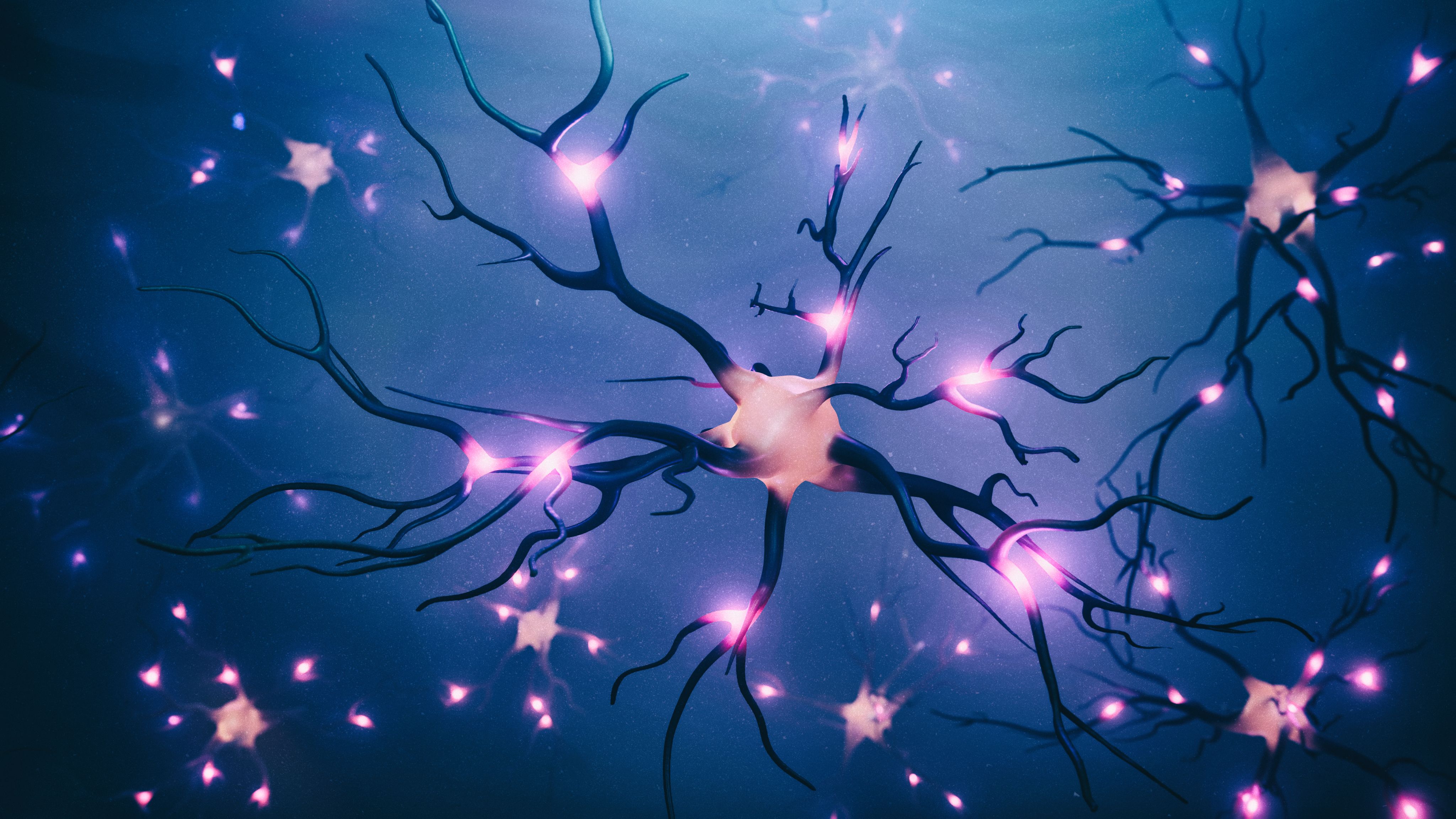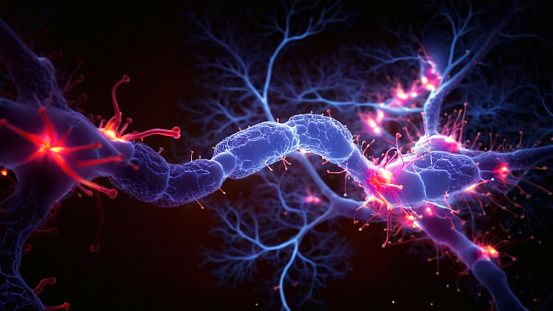Rewiring the Brain
How deep brain stimulation is giving new hope to patients with
Parkinson’s disease and other neurological disorders

Deep brain stimulation (DBS) is a surgical procedure that involves implanting thin wires, called leads, connected to electrodes in specific areas of the brain to treat a growing number of disorders and diseases. The primary nerve cells of the brain, called neurons, communicate with one another through electrical signals. When a breakdown in this signaling occurs, it can lead to a variety of neurological or psychological disorders.
Much like a heart pacemaker sends electrical signals to the heart to stabilize its beating rhythm, DBS impulses can help modulate abnormal brain activity, leading to a reduction in symptoms.
DBS has been in the clinic since the 1990s, when it was first used to help treat tremors associated with Parkinson’s disease and other movement disorders. Since then, DBS has been applied to an increasing number of disorders, including epilepsy, stroke, depression, traumatic brain injury, and obsessive-compulsive disorder (OCD). In addition, advances in brain activity recording technology have ushered in the next generation of DBS technology.
How does DBS work?

For patients receiving DBS treatment, surgeons insert very fine electrodes—a little more than a millimeter in diameter—into the brain. Because they are so small, the wires can be driven deep into the tissue while being precisely targeted to a specific region of the brain. For example, in people with Parkinson’s disease, the target is often one of two regions: the subthalamic nucleus or the internal segment of the globus pallidus.
Once the electrodes are in place, they are hooked up to a device called a neurostimulator, which is a small pacemaker like device that is implanted under the skin near the collarbone that controls the level and type of stimulation. Neurostimulator settings are adjusted in the clinic to find the right amount of stimulation that decreases symptoms while minimizing unwanted side-effects. In addition, these levels are not set in stone—if the person’s needs or symptoms change over time, the stimulation can be adjusted accordingly by a visit to the clinic.
While DBS has been used to safely and successfully treat Parkinson’s disease symptoms for more than 25 years, it is not without limitations. Once the neurostimulator is tuned in the clinic and the patient is sent home, the stimulation being delivered remains constant unless the individual being treated returns to the clinic for adjustments. Continuous stimulation may lead to unwanted side effects such as involuntary muscle movements called dyskinesia or a slowness of movement called bradykinesia. The benefits of constant stimulation can also change over time as the brain adapts to the DBS. These unwanted effects can often be addressed by adjusting the neurostimulator in the clinic; however, symptoms may reappear over time as the brain adapts to the new level of stimulation or as the disease progresses.
Subthalamic Nucleus (red)
Subthalamic Nucleus (red)
Globus pallidus (red)
Globus pallidus (red)
Recent Advances in DBS for Parkinson’s Disease

In recent years, research funded in part by NINDS and the National Institutes of Health’s Brain Research Through Advancing Innovative Neurotechnologies® (BRAIN) Initiative has led to breakthroughs that could significantly improve DBS treatment.
Research funded by the NIH BRAIN Initiative has developed advanced neurotechnologies, such as DBS, which has helped encourage further investment to bring these innovations into clinical practice.
Although conventional DBS delivers a constant level of stimulation all the time, a person’s symptoms tend to fluctuate throughout the day. In addition, many people with Parkinson’s disease take medications like levodopa to help manage their symptoms. Unlike DBS, the effectiveness of medication is not constant, as it is often at its highest right after being taken and then gradually decreases over time until the next dose is administered. This means that there are times during the day when a person needs more help from DBS to manage symptoms and other times when they need less. However, conventional DBS does not allow for this kind of fine tuning.
One of the biggest steps forward in improving DBS technology came from asking a deceptively simple question: can we “ask” the brain how it is doing at any one time? In other words, maybe the brain itself can tell us how much stimulation it needs at any one time. If so, could the neurostimulator be adjusted “on the fly” based on what level of stimulation is needed at any one time?
Developing a DBS system that adapts to the needs of the patient
Among the researchers looking to answer these questions is Philip Starr, M.D., Ph.D. at the University of California, San Francisco. Using a modified neurostimulator device that can receive input as well as send signals, Starr and his research group developed in 2018 what is called a closed-loop (or adaptive) DBS system, which they tested in two people with Parkinson’s disease.
Sensory electrodes are placed in an area of the brain called the primary motor cortex. This area is critical for producing normal movements and is affected by Parkinson’s disease.
These electrodes then feed into the neurostimulator device, which uses a computer algorithm to interpret the signals coming from the motor cortex.
This algorithm had been trained to recognize brain signals associated with dyskinesia, which are uncontrolled movements that can be a side-effect of DBS.
When dyskinesia-associated signals were detected, the computer turned down the level of stimulation. When no dyskinesia was detected, the stimulation was turned back up.
Even though the level of stimulation changed over time as a result, no differences in the effectiveness of the DBS therapy were observed by the doctors or the participants.
While this was an important first step to determining the feasibility of an adaptive DBS (aDBS) system, several hurdles remained. This was a short-term study, which meant that there was not enough time to determine whether the dyskinesia side effects were improved. More importantly, the recording was done in the clinic. For aDBS to truly be a workable treatment, the ability to record and use brain data would have to move out of the clinic to where participants lived—their own homes. This NIH-funded research was a catalyst to industry sponsored research into aDBS. Recently, with the conclusion of the ADAPT trial, Medtronic recently secured Conformité Européenne (CE) Mark approval for aDBS in the European Union and United Kingdom.
Wireless home recording of brain activity
A breakthrough occurred in 2021, as Starr and his colleagues, led by Ro’ee Gilron, Ph.D., developed a system to continuously record the activity of the brain and to send those recordings wirelessly to a pocket-sized device worn by the individual.
These recordings could then be sent via Bluetooth to a nearby iPad-like device and then shared with the clinic using a HIPAA-compliant cloud server.
“This technology allows us to perform hours of brain recordings while the patients go about their normal lives.”
—Philip Starr, M.D., Ph.D.
The importance of being able to record hours of brain activity in a normal, everyday environment cannot be understated:
- The brain activity patterns associated with Parkinson’s disease, called biomarkers, were almost exclusively recorded in the clinic. This new technology now makes it possible to validate those biomarkers during ordinary, daily activities.
- Recording hours of data from a single person means that symptom-related biomarkers that are unique to that individual can be identified.
We can now build a biomarker library unique to each patient and program the DBS unit to their individual needs.
Building to a self-regulating brain pacemaker
In August 2024, yet another step was taken towards developing an adaptive DBS system for Parkinson’s disease, which has now also received FDA approval. Four people who were already receiving conventional DBS were set up to also be treated with aDBS.
- First, the participants were asked which was the most bothersome symptom that remained despite DBS treatment.
- The aDBS machine learning algorithm was trained over a period of months using individual brain recording data from each participant.
- The participants were sent home for the comparison test: they received either conventional or aDBS and the treatment was switched every 2-7 days.
- On average, aDBS provided a 50% improvement in each participant’s “most bothersome symptom” compared to conventional DBS.
- While the participants were not told which treatment they were receiving at any one time, three of the four were able to correctly guess when they were receiving aDBS based on how they were feeling and their symptoms.
While these findings are some of the most promising yet, they are still very preliminary. Although the aDBS system appears to function quite well in responding to changes in brain activity, it first must learn what activity signatures (biomarkers) to look for. It’s possible that these might be different for each patient, and right now, the process takes several months under direct supervision in the clinic. One of the projects Dr. Starr and his team are working on now is a way to improve this process so that it can one day be done automatically by the device itself.
Revolutionary Parkinson's Treatment Shows Promise in Clinical Trials
What if we could stop Parkinson's symptoms before they even start?

UCSF researchers are making that possibility a reality with groundbreaking adaptive deep brain stimulation technology. Unlike traditional treatments that deliver constant electrical pulses, this smart device actually "listens" to the brain, detecting the earliest signs of symptom development and responding with precisely calibrated stimulation.
The results from recent clinical trials are remarkable – patients are experiencing significant symptom relief with a treatment that adapts to their unique neurological patterns in real-time. This personalized approach represents a significant leap forward in Parkinson's care, offering hope for millions living with this challenging condition.
See how this cutting-edge technology is transforming lives and what it could mean for the future of neurological treatment.
Watch the whole story for ~ 3 minutes.
Using DBS to treat other brain disorders

In addition to Parkinson’s disease and other movement disorders such as essential tremor and dystonia, DBS has been approved by the U.S. Food and Drug Administration (FDA) to treat medication-resistant epilepsy by targeting the anterior nucleus of the thalamus.
Thanks to efforts like the NIH BRAIN Initiative, clinical researchers are working to apply DBS treatments to even more disorders. These studies often take advantage of advances in artificial intelligence and machine learning technologies to, like the studies by Dr. Starr and colleagues described above, identify specific biomarkers within brain activity patterns. While they are in early stages today, projects are looking to apply DBS to treat the following:
- Post-stroke motor deficits by targeting the cerebellum
- Treatment-resistant depression
- Restoration of lost function following traumatic brain injury
- Tourette Syndrome
- Post-traumatic stress disorder
- Bipolar Disorder
- Loss of control of eating
- Pain
Learn More
- Deep brain stimulation (DBS) for the treatment of Parkinson’s disease and other movement disorders
- Self-tuning brain implant could help treat patients with Parkinson’s disease (May 19, 2018)
- Researchers wirelessly record human brain activity during normal life activities (May 3, 2021)
- Self-adjusting brain pacemaker may help reduce Parkinson’s disease symptoms (August 19, 2024)
- National Institute of Neurological Disorders and Stroke (NINDS)
- NIH BRAIN Initiative





